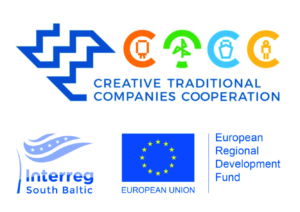EVALUATING & MEASURING CTCC
As a part of the development of the triple-helix creative-traditional business partnership platform, the EVALUATING & MEASURING the success of the cooperation between these two sectors represent a substantial part of the CTCC project.
The triple helix model of innovation is a methodological tool reflecting the effect of the interactions between academia, industry, and government. Overlaying of communications among these three elements leads to the evolution of each element followed by the adoption of some characteristics of other institutions. The triple helix model visualizes the emerging of hybrid institutions such as technology transfer offices and science parks, helps to understand entrepreneurship, innovation, and socio-economic development.
Pic. №1 Triple-Helix Model of Innovation
Creative-Traditional Evaluation and Measurement Methodology is used to measure the effects of cross-border cooperation between Creative Industries and SMEs of the traditional sector. These effects are the transfer of value added from the Creative Industries (CIs) to traditional sector SMEs; the short- and long-term impact of CIs to traditional industry sector; innovation transfer to traditional sectors. The methodology helps to find, compare & evaluate data on the value of spill-overs and crossovers for cross-innovation in creative-traditional partnerships.
In CTCC we concentrate on industry spillovers. The main topic is to measure the value of spillovers and cross-sectorial collaboration considering the financial, industrial, infrastructural, market, cultural, knowledge and competence, regulatory and policy, and support framework conditions. The aim of the triple-helix-stakeholders is to support favorable framework conditions in the economic sector.
Table №1 Existing tools to measure spillovers of cross-sectoral collaboration under involvement of creative industries
Creative-Traditional Evaluation and Measurement Methodology is used in the State of the Region Study on Creative-Traditional Business Partnership Platform. The study shows regional capacities, integrating all actors (academia & research; business; policy and intermediaries) into one cross-border creative-traditional business platform. It includes an empirical evaluation of strengths, weaknesses, opportunities, threats & future recommendations.
Pic. №2 Visualisation of Spillover Effects
The effectiveness of cross-sectorial cooperation and innovation development is measured with the next KPIs:
- Number of joint activities between sectors
- a) Number of jointly created innovations
b) Number of jointly implemented innovations - a) Number of jointly created products/ services
b) Number of jointly implemented products/ services - Budget for innovations: a) planned
b) realized - Funds invested in activities
- Revenues from innovative products or services
- Revenues generated by innovations
- Hours of work: a) Planned
b) Worked hours - Percentage of canceled projects/ innovations
- Customer Satisfaction/Loyalty
- Number of Returns
Companies can check which Key Success Factors is/are the most important for them, they have to scale each of the factors, the weight and importance of these factors (total give 1,0 point) and later they need to give them rank, from 1 to 5; where 1 is the less important and 5 is the most important factor.
- Key Success Factors
- Factor 1
- Factor 2
- Factor 3
- Factor 4
- Factor 5
- TOTAL
- Scales
- e.g. 0,3
- e.g. 0,4
- e.g. 0,1
- e.g. 0,15
- e.g. 0,05
- 1,0
- Rank (1-5)
- e.g. 3
- e.g. 4
- e.g. 5
- e.g. 1
- e.g. 4
- TOTAL
- Weighted value
- 0,3 x 3 = 0,9
- 0,4 x 4 = 1,6
- 0,1 x 5 = 0,5
- 0,15 x 1 = 0,15
- 0,05 x 4 = 0,2
- 3,35 points on 5 points possible to get
The reports below provide a detailed description of the Creative-Traditional Business Partnership Evaluation and Measurement Methodology, which could help to analyze data on the value of spill-overs and crossovers for Creative Industries and SMEs of the traditional sector. More information about the methodology can be found in the following documents.
The study introduces the important harmonized Key Performance Indicators (KPI) and Critical Success Factors (CSF) for measuring the effectiveness of cross-sectoral collaboration & developed innovations. Detailed information about the KPIs and CSFs can be found in the document below.


